
Source: Thinkstock
Asking prices for homes in 98 of the 100 largest U.S. metropolitan areas are up an average of 9.5% year-over-year including foreclosed homes and 10.5% excluding foreclosures on a seasonally adjusted basis. Asking prices are up 1.1% month-over-month and 4% quarter-over-quarter. Perhaps more telling, asking prices are rising faster in some higher-cost, least affordable markets.
The three metro areas where asking prices are rising the most are all in California: Oakland (up 31.2%), San Jose (up 23.2%), and Orange County (up 21.2%). A mitigating factor to the rise in asking prices is the relatively low percentage of average monthly income that is needed to pay the homeowner’s mortgage.
In Oakland, a homeowner would pay about 37% of the area’s average monthly income for a mortgage. The percentage drops to 33% in San Jose, but jumps to 44% in Orange County.
In the San Jose metropolitan area, wages are notoriously high and home prices are equally notorious for their nosebleed levels. But at 33% of the average salary, the
In Honolulu, however, where the asking prices are up nearly 13% in the past year, a mortgage consumes 74% of average monthly income, while a mortgage in San Francisco eats up 55% of average pay.affordability of house in San Jose is the best among the 10 least affordable markets.
Based on a percentage of monthly income required to pay the mortgage, the most affordable houses are for sale in Detroit, where just 8% of an average salary will meet the monthly mortgage payment. Houston and Atlanta (12%) are next, followed by the Memphis area at 13%.
Rents have not been rising as fast, with the top year-over-year change in asking price up 6.4% in Miami. Rents are up 5.5% in Boston, 5.1% in San Diego, and 3.7% in New York City. But a New York rental consumes 58% of an average monthly income.
The data comes from Trulia Inc. (NYSE: TRLA) and the company says that its data on asking prices leads information on sales prices by about two months. Trulia’s chief economist notes two aspects of what he calls a “widening affordability gap”:
First, as local markets become more unequal, more people will consider moving from less affordable to more affordable areas. … Therefore, widening affordability gaps could cause more people to make long-distance moves to a more affordable local housing market. … Second, a widening affordability gap puts pressure on housing policy. It’s harder to come up with one-size-fits-all national housing policies when local markets are becoming more different from each other.
Essential Tips for Investing: Sponsored
A financial advisor can help you understand the advantages and disadvantages of investment properties. Finding a qualified financial advisor doesn’t have to be hard. SmartAsset’s free tool matches you with up to three financial advisors who serve your area, and you can interview your advisor matches at no cost to decide which one is right for you. If you’re ready to find an advisor who can help you achieve your financial goals, get started now.
Investing in real estate can diversify your portfolio. But expanding your horizons may add additional costs. If you’re an investor looking to minimize expenses, consider checking out online brokerages. They often offer low investment fees, helping you maximize your profit.
Thank you for reading! Have some feedback for us?
Contact the 24/7 Wall St. editorial team.



